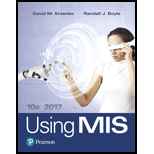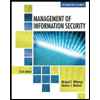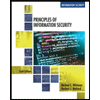
Using MIS (10th Edition)
10th Edition
ISBN: 9780134606996
Author: David M. Kroenke, Randall J. Boyle
Publisher: PEARSON
expand_more
expand_more
format_list_bulleted
Concept explainers
Question
Chapter 1.7, Problem 3SGDQ
Program Plan Intro
Password:
Sensitive information is present in every system or network and it requires authentication to open.
- The authorization is provided by entering the password, identification number, and so on.
- Password can be a string of character or number and it protects the system from the access of the unauthorized person.
Rule for creating a password:
The rules for creating password are:
- Password should be changed often.
- Password should not be guessable such as first name, last name and so on.
- The length of the password should be minimum 8 characters or more in length.
- It is good, if it has uppercase letters, lowercase letters, numbers, and special characters.
- It should not be a familiar word or pharse.
- It should not be common numbers like birth date and social security number.
- Password should not be shared with others.
Example of Weak password:
The examples of weak password are “FirstName_123”, “mypassword”, “mobile_number” and “123456789”.
Example of strong password:
The password with the combination of uppercase letters, lowercase letters, numbers, and special characters are considered as strong password.
Expert Solution & Answer
Want to see the full answer?
Check out a sample textbook solution
Students have asked these similar questions
I need to define and discuss the uses of one monitoring or troubleshooting tool in Windows Server 2019. thank you
I would likr toget help with the following concepts:
- Windows Server features
- Windows Server versus Windows 10 used as a client-server network
I need to define and discuss the uses of one monitoring or troubleshooting tool in Windows Server 2019. thank you
Chapter 1 Solutions
Using MIS (10th Edition)
Ch. 1.4 - Prob. 1AAQCh. 1.4 - Prob. 2AAQCh. 1.4 - Prob. 3AAQCh. 1.4 - Prob. 4AAQCh. 1.7 - Prob. 1EGDQCh. 1.7 - Prob. 2EGDQCh. 1.7 - Prob. 3EGDQCh. 1.7 - Prob. 4EGDQCh. 1.7 - Prob. 5EGDQCh. 1.7 - Prob. 6EGDQ
Ch. 1.7 - Prob. 7EGDQCh. 1.7 - Prob. 8EGDQCh. 1.7 - Prob. 1SGDQCh. 1.7 - Prob. 2SGDQCh. 1.7 - Prob. 3SGDQCh. 1.7 - Prob. 4SGDQCh. 1.7 - Prob. 5SGDQCh. 1.7 - Prob. 1CGDQCh. 1.7 - Prob. 2CGDQCh. 1.7 - Prob. 3CGDQCh. 1.7 - Prob. 4CGDQCh. 1.7 - Prob. 1ARQCh. 1.7 - Prob. 2ARQCh. 1.7 - Prob. 3ARQCh. 1.7 - How can you use the five-component model? Name and...Ch. 1.7 - Prob. 5ARQCh. 1.7 - Prob. 6ARQCh. 1.7 - Prob. 7ARQCh. 1 - Prob. 1.1UYKCh. 1 - Prob. 1.2UYKCh. 1 - Prob. 1.3UYKCh. 1 - Prob. 1.4CE1Ch. 1 - Prob. 1.5CE1Ch. 1 - Prob. 1.6CE1Ch. 1 - Prob. 1.7CE1Ch. 1 - Prob. 1.8CE1Ch. 1 - Prob. 1.9CS1Ch. 1 - Prob. 1.1CS1Ch. 1 - Prob. 1.11CS1Ch. 1 - Prob. 1.12CS1Ch. 1 - Prob. 1.13CS1Ch. 1 - Prob. 1.14CS1Ch. 1 - Prob. 1.15MML
Knowledge Booster
Learn more about
Need a deep-dive on the concept behind this application? Look no further. Learn more about this topic, computer-science and related others by exploring similar questions and additional content below.Similar questions
- Please solve and answer the questions correctly please. Thank you!!arrow_forwardConsidering the TM example of binary sum ( see attached)do the step-by-step of execution for the binary numbers 1101 and 11. Feel free to use the Formal Language Editor Tool to execute it; Write it down the current state of the tape (including the head position) and indicate the current state of the TM at each step.arrow_forwardI need help on inculding additonal code where I can can do the opposite code of MatLab, where the function of t that I enter becomes the result of F(t), in other words, turning the time-domain f(t) into the frequency-domain function F(s):arrow_forward
arrow_back_ios
SEE MORE QUESTIONS
arrow_forward_ios
Recommended textbooks for you
 Management Of Information SecurityComputer ScienceISBN:9781337405713Author:WHITMAN, Michael.Publisher:Cengage Learning,
Management Of Information SecurityComputer ScienceISBN:9781337405713Author:WHITMAN, Michael.Publisher:Cengage Learning, Principles of Information Systems (MindTap Course...Computer ScienceISBN:9781305971776Author:Ralph Stair, George ReynoldsPublisher:Cengage Learning
Principles of Information Systems (MindTap Course...Computer ScienceISBN:9781305971776Author:Ralph Stair, George ReynoldsPublisher:Cengage Learning Principles of Information Systems (MindTap Course...Computer ScienceISBN:9781285867168Author:Ralph Stair, George ReynoldsPublisher:Cengage Learning
Principles of Information Systems (MindTap Course...Computer ScienceISBN:9781285867168Author:Ralph Stair, George ReynoldsPublisher:Cengage Learning Fundamentals of Information SystemsComputer ScienceISBN:9781305082168Author:Ralph Stair, George ReynoldsPublisher:Cengage Learning
Fundamentals of Information SystemsComputer ScienceISBN:9781305082168Author:Ralph Stair, George ReynoldsPublisher:Cengage Learning Systems ArchitectureComputer ScienceISBN:9781305080195Author:Stephen D. BurdPublisher:Cengage Learning
Systems ArchitectureComputer ScienceISBN:9781305080195Author:Stephen D. BurdPublisher:Cengage Learning Principles of Information Security (MindTap Cours...Computer ScienceISBN:9781337102063Author:Michael E. Whitman, Herbert J. MattordPublisher:Cengage Learning
Principles of Information Security (MindTap Cours...Computer ScienceISBN:9781337102063Author:Michael E. Whitman, Herbert J. MattordPublisher:Cengage Learning

Management Of Information Security
Computer Science
ISBN:9781337405713
Author:WHITMAN, Michael.
Publisher:Cengage Learning,

Principles of Information Systems (MindTap Course...
Computer Science
ISBN:9781305971776
Author:Ralph Stair, George Reynolds
Publisher:Cengage Learning

Principles of Information Systems (MindTap Course...
Computer Science
ISBN:9781285867168
Author:Ralph Stair, George Reynolds
Publisher:Cengage Learning

Fundamentals of Information Systems
Computer Science
ISBN:9781305082168
Author:Ralph Stair, George Reynolds
Publisher:Cengage Learning

Systems Architecture
Computer Science
ISBN:9781305080195
Author:Stephen D. Burd
Publisher:Cengage Learning

Principles of Information Security (MindTap Cours...
Computer Science
ISBN:9781337102063
Author:Michael E. Whitman, Herbert J. Mattord
Publisher:Cengage Learning